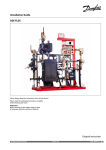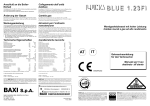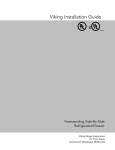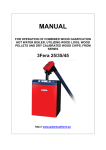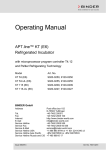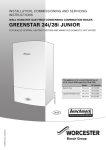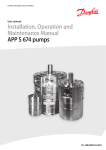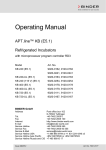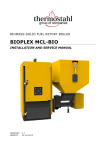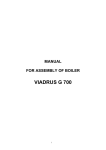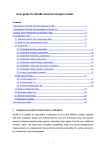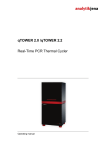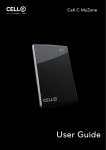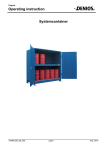Download Installation Guide DSA WALL
Transcript
Installation Guide DSA WALL Please always keep the instructions close to the device! Please read the operating instructions carefully before starting any work. Attention! Before starting up the station, please check it for proper function and free of defects! Original instruction Danfoss District Energy VI.IQ.J1.02 DEN-SMT/PL 1 Installation Guide DSA WALL 0.0 Table of contents 0.0 Table of contents ............................................................................................................................................................................................................................2 1.0 General notes ...................................................................................................................................................................................................................................3 1.1 Information about Operating Instructions.......................................................................................................................................................................3 1.2 Applicable Documents ............................................................................................................................................................................................................3 1.3 Explanation of symbols ...........................................................................................................................................................................................................3 1.4 Liability and Warranty...............................................................................................................................................................................................................3 1.5 Copyright Protection................................................................................................................................................................................................................4 1.6 Spare parts ...................................................................................................................................................................................................................................4 1.7 Substation disassembly...........................................................................................................................................................................................................4 1.8 Disposal ........................................................................................................................................................................................................................................4 2.0Safety............................................................................................................................................................................................................................................5 2.1 General information .................................................................................................................................................................................................................5 2.2 Responsibility of substation operator ..............................................................................................................................................................................5 2.3 Intended use...............................................................................................................................................................................................................................5 2.4 Possible misuse..........................................................................................................................................................................................................................5 2.5 Safety work..................................................................................................................................................................................................................................5 2.6 Personal protective equipment ...........................................................................................................................................................................................6 2.7 Risks associated with the substation .................................................................................................................................................................................6 2.8 Emergency stop switch ..........................................................................................................................................................................................................7 2.9 Operators .....................................................................................................................................................................................................................................7 2.10 Steps to follow in the event of danger or accidents....................................................................................................................................................7 2.11 Residual hazards / risk analysis ............................................................................................................................................................................................8 3.0 Technical data ..................................................................................................................................................................................................................................9 3.1 Technical information ..............................................................................................................................................................................................................9 3.1.1 CE label ...............................................................................................................................................................................................................................9 3.1.2 Dimensions and packaging ........................................................................................................................................................................................9 3.2 Symbols used in circuit diagrams ..................................................................................................................................................................................... 10 4.0 Function and configuration ..................................................................................................................................................................................................... 11 4.1 Function ..................................................................................................................................................................................................................................... 11 4.2 DSA WALL configuration possibilities - Primary side ................................................................................................................................................ 11 4.3 DSA WALL configuration possibilities - Heating side ................................................................................................................................................ 12 4.4 DSA WALL configuration possibilities - Domestic Hot Water side ........................................................................................................................ 12 4.5 DSA WALL - modularity ........................................................................................................................................................................................................ 12 5.0 Transport, packaging and storage ......................................................................................................................................................................................... 13 5.1 Transport of pallets by forklift ......................................................................................................................................................................................... 13 5.2 Transport inspection ............................................................................................................................................................................................................. 13 5.3 Packaging ................................................................................................................................................................................................................................. 14 5.4 Storage ..................................................................................................................................................................................................................................... 14 6.0Installation ...................................................................................................................................................................................................................................... 14 6.1 Installation preparation ..................................................................................................................................................................................................... 15 6.1.1 Primary connection .................................................................................................................................................................................................... 15 6.1.2 Secondary connection ............................................................................................................................................................................................... 15 6.1.3 Electrical connection .................................................................................................................................................................................................. 15 6.2 Packaging / unpacking the substation ......................................................................................................................................................................... 16 6.3 Substation assembly ........................................................................................................................................................................................................... 17 6.4 Draining station .................................................................................................................................................................................................................... 18 7.0Commissioning ............................................................................................................................................................................................................................. 19 7.1 Requirements for commissioning .................................................................................................................................................................................. 19 7.2 Secondary side commissioning ...................................................................................................................................................................................... 19 7.3 Primary-side commissioning ........................................................................................................................................................................................... 19 7.4 Requirements for commissioning .................................................................................................................................................................................. 20 7.5 Fault and Shutdown ............................................................................................................................................................................................................ 20 7.6 Commissioning after a failure or malfunctioning .................................................................................................................................................... 20 8.0 Operation ...................................................................................................................................................................................................................................... 20 8.1 Switching on .......................................................................................................................................................................................................................... 20 8.2 Switching off .......................................................................................................................................................................................................................... 20 8.3 Restarting after substation shutdown .......................................................................................................................................................................... 20 8.4 Service / clean - strainer ..................................................................................................................................................................................................... 21 8.5 Service / disassembly and replacement - heat exchanger .................................................................................................................................... 22 8.6 Service / Check - Safety valve and expansion vessel ................................................................................................................................................ 23 9.0 Maintenance ................................................................................................................................................................................................................................ 24 9.1 Safety warning ...................................................................................................................................................................................................................... 24 9.2 Maintenance plan (recommendations) ....................................................................................................................................................................... 24 9.3 Heat exchanger maintenance ......................................................................................................................................................................................... 25 9.4 Maintenance validation ..................................................................................................................................................................................................... 25 10.0 Troubleshooting ................................................................................................................................................................................................................. 26 10.1 Safety ..................................................................................................................................................................................................................................... 29 11.0 Spare parts ............................................................................................................................................................................................................................ 29 12.0 Index .............................................................................................................................................................................................................................. 30 2 DEN-SMT/PL VI.IQ.J1.02 Danfoss District Energy Installation Guide DSA WALL 1.0 General notes 1.1 Information about Operating Instructions This manual describes the installation, operation and maintenance of the substation. Compliance with all safety and operating instructions is a prerequisite for the safe operation and proper use of the substation. In addition, regulations applicable to the field of application of the substation, local accident prevention regulations and general safety regulations must be followed. The operating manual is part of the product and must be available at all times within the immediate vicinity of the operating area of the substation for the installation, operation, maintenance and cleaning responsible of the substation. The graphic illustrations in this manual are provided to better represent the issues described, and are not necessarily to scale and may differ slightly from the actual design of the substation. In addition to these operating instructions, operating manuals for all installed components on substation must be followed. The information contained therein - particularly with regard to safety - must be followed! 1.2 Applicable Documents Individual system components - unless otherwise indicated - are components purchased from other manufacturers. All components used in the substation have been subjected to their manufacturers’ risk assessments. Declarations of conformity with current European and national legislation have been made by the manufacturers of the components. Declarations of conformity, and operation, maintenance and repair instructions for the individual components are integral parts of the substation documentation. The instructions contained in the manufacturer’s documents for security, set-up, installation, operation, maintenance, and dismantling and disposal of the components must be followed strictly. 1.3 Explanation of symbols Important security and device-related information in these operating instructions is marked by warning notices. The instructions must be followed to prevent accidents, personal injury or property damage. WARNING This symbol indicates a danger that may result in damage to health, injury, permanent physical injury or death. Please follow the notes for working safely very carefully and take extreme care in these situations! WARNING Electrical hazard! This symbol indicates danger from electricity. Failure to follow safety procedures can result in severe injury or death. This work may only be performed by a trained electrician. ATTENTION This symbol indicates a risk that may result in damage to, or malfunction / failure of equipment if ignored. NOTE This symbol highlights tips and information that must be followed for the efficient and trouble-free operation of the substation. 1.4 Liability and Warranty All information and instructions in this manual have been compiled in accordance with applicable regulations and the current status of engineering developments as well as our many years of knowledge and experience. The actual scope of delivery may differ from the explanations and graphic representations of special versions described here, as a result of additional accessories / order options or latest technical changes. For questions, please contact Danfoss directly. We reserve the right to make technical changes to the product in the course of improvement of its functional properties and further development. Items such as tools and equipment that may wear out during use of the device, as well as auxiliary materials and supplies such as oils, greases and detergents, are not covered by warranty. Danfoss District Energy In addition, the commitments agreed in the contract, such as the general terms and conditions and the manufacturer’s terms of delivery, and statutory regulations at the time the contract is concluded shall apply. NOTE These operating instructions should be read carefully before starting work on or with the substation, and in particular before commissioning! The manufacturer will not accept claimsfor damage or faults arising from non-compliance with these operating instructions. VI.IQ.J1.02 DEN-SMT/PL 3 Installation Guide DSA WALL 1.5 Copyright Protection Operating instructions must be kept confidential. These are intended exclusively for the persons employed on and with the substation. Transfer of the operating instructions to third parties without written approval of the manufacturer is prohibited. If such approval is required, please contact Danfoss directly. This document and any others delivered with the substation are protected by copyright. Copies (whether whole or in part) are allowed only with the permission of the manufacturer. Violators will be liable to prosecution. All other rights reserved. NOTE Contents of this instruction – texts, drawings, images or other illustrations are copyrighted and subject to other intellectual property rights. Any improper reuse is forbidden. 1.6 Spare parts Use only original spare parts from the manufacturer. The use of non-approved spare parts will invalidate any guarantees, or service, compensation and liability claims against the manufacturer or its agents, distributors and representatives. ATTENTION Using the wrong or faulty spare parts can lead to damage, malfunction or total failure of the substation. 1.7 Substation disassembly Clean and sort the substation parts and components in compliance with applicable health and safety and environmental regulations. Before starting disassembly: • Switch the unit OFF and secure against being switched ON again. • Ensure that the entire energy supply is physically separate from the substation and that stored residual power is properly discharged. • Remove supplies and materials as well as any remaining processing materials in an environmentally friendly manner. WARNING Risk of injury! Stored residual power, components with sharp edges, edges and corners on and inside the substation or necessary tools can cause personal injury. Any substation removal work must therefore be carried out only by a specialist. WARNING Do not drink! Water in the installation which has not been used for a long period of time may not meet the quality standard for drinking water in certain conditions. Prevent such use and drain or dispose of water used to run the substation. 1.8 Disposal If no withdrawal or waste management agreement has been concluded, disassemble the dismantled components for recycling: • Metal to scrap material • Plastics to plastics recycling • To dispose other components, sort by material properties • Remove any residual media and dispose of properly media with additives (e.g. glycol) must comply with relevant legislation Remove operating materials such as lubricants, oils, fats, cleaning agents and inhibitors from the substation in an environmentally friendly manner . In this case, use a suitable, approved container for lubricants. Mark the container with information about the content and level, and date clearly. Secure final disposal of the materials so that improper use is excluded. 4 DEN-SMT/PL WARNING Electrical and electronic components, lubricants and other excipients must be handled by hazardous waste treatment plants and may only be disposed by approved specialist companies! VI.IQ.J1.02 Danfoss District Energy Installation Guide DSA WALL 2.0 Safety This section gives an overview of all the important security aspects of optimal protection of personnel as well as of safe and troublefree operation of the substation. In addition, these chapters include specific safety symbols in order to avert immediate safety hazards. 2.1 General information Substation is built at the time of its development and manufacturing according to existing, accepted engineering standards and is safe to operate. The substation can be dangerous if used by improperly trained personnel or used improperly or by unauthorised persons. Any person authorised to work on or with the substation must read and understand the operating instructions before starting work. We recommend advising the operator to obtain confirmation from staff proven understanding of the instruction manual. Modifications of any kind as well as additions or modifications to the substation are forbidden. All substation security, warning and operating instructions must be maintained in good legible condition. Damaged labels or stickers must be replaced immediately. Specified values or ranges must be strictly adhered to. NOTE For modification and extension activities, always consult with the substation manufacturer. 2.2 Responsibility of substation operator • Operating instructions must always be stored within the immediate vicinity of the substation and must be accessible at all times for installation, operation and maintenance and to cleaning staff. • Operate the substation only if it is in a proper technical and safe operating condition. • Check that safety devices are always kept freely accessible test them regularly. Information about industrial safety is based on the European Union regulations valid at the time of manufacture of the substation. The operator is obliged throughout the entire lifetime of the substation to conform to those safety actions designated in the current rules and regulations and to comply with those in new regulations. Outside of the European Union, the safety laws, local rules and regulations applicable to the location where the substation operates must be followed. In addition to the safety instructions in this manual, and for substation safety in general, accident prevention and environmental protection regulations must be observed and followed. The operator and authorised personnel are responsible for the trouble-free operation of the substation, as well as for the clear definition of responsibilities for installation, operation, maintenance and cleaning of the substation. There must be no deviation from the information in the operating instructions! The operator shall also ensure that: • Any further risks are identified in an assessment of risks arising from the special working conditions at the operations site. • That any additional work and safety instructions resulting from the risk assessment of activities performed on the substation are described in a standard operating procedure (SOP). Always follow local regulations as well as any existing ordinances on industrial safety and health (e.g. in Germany: BetrSichV, BGBL I 2002, 3777). 2.3 Intended use Operational safety is guaranteed only where the substation is used properly and in accordance with the instructions / details in this manual. A district heating substation is used to provide heat energy from the district heating utility grid by transferring heat to customer installation systems. Intended use also includes compliance with instructions for installation, operation, maintenance and cleaning. Any additional and / or other use of the substation is forbidden and considered as improper use! Any claims against the manufacturer and / or its representative for any loss or damage as a result of improper use of the substation are excluded. The operator and / or owner shall be solely liable for any damage arising when the substation is used for any purpose other than. 2.4 Possible misuse WARNING. Hazard from improper use! Any use of the substation apart from its intended use may lead to dangerous situations. Therefore: • Use the district heating transfer station only for its intended purpose and in accordance with the information provided in this document, particularly the limitations given in the technical data. • Avoid any further or other use of the district heating transfer station. • It is forbidden to change, upgrade or modify the design or 2.5 Safety work Hazards to persons and / or the system can be prevented by following the safety at work instructions. Danfoss District Energy Failure to follow these instructions can result in mechanical or equipment failure that poses a danger to persons and goods and the entire workplace. Failure to comply with safety regulations will invalidate any warranty. VI.IQ.J1.02 DEN-SMT/PL 5 Installation Guide DSA WALL 2.6 Personal protective equipment While working on and with the substation the following must be worn at all times: Protective goggles to protect the eyes from flying parts and liquid splashes. Protective clothing is close-fitting work clothing with low tensile strength and tight sleeves and without protruding parts. Its main purpose is to guard against snagging on moving machine parts. Do not wear rings, chains or other jewelry. Protective gloves to protect the hands from friction, abrasion, puncture or deeper injury as well as from contact with hot surfaces. Safety shoes to protect from heavy falling parts and losing traction on slippery surfaces. Helmet to protect against falling or flying parts and materials. 2.7 Risks associated with the substation The substation has been subjected to a risk analysis based on the design and construction of the substation and in correspondence with the current state of technology. Nevertheless, risks remain! The substation can generate a hot stream of fluid or steam when e.g. a drain or air vent is opened. Therefore: • Depressurise before starting any work on the substation. • Do not remove or alter any safety devices or put out of service. • Do not change the default settings from the values or beyond the tolerance ranges specified in the operating manual The substation has sharp edges and corners. WARNING! Risk of injury! Risk from liquids splashing under high pressure. Wear personal protective equipment for all operations carried out on the substation! WARNING! Risk of injury! Sharp-edged parts and sharp edges may cause abrasion to the skin. Wear protective gloves when working on the substation. The substation operates with high electrical voltages of up to 400 V and currents of up to 25 A. WARNING! Electrical shock hazard! Electrical energy can cause serious injury. Damaged insulation or components can lead to serious injury or death. • Switch OFF the main switch and secure against reconnection before performing any maintenance, cleaning or repair. • Turn off the power switch when performing any work with the electrical system • Do not remove any safety devices or put out of operation The substation is supported by pneumatic components. WARNING! Risk of injury! Risk from liquids splashing under high pressure. Wear personal protective equipment for all operations carried out on the substation! 6 DEN-SMT/PL WARNING! Risk of burns! Hot surfaces can cause serious burns. For all operations carried out on the substation always wear protective gloves! Components inside of the station can contain automatically moving parts (pumps, actuators, etc.). The devices can be very heavy. WARNING! Danger of crushing! During transport or lifting of the substation, bruising can occur due to heavy weight. The substation may include electrical components (engines, transmissions) which may also cause bruising if contacted while in operation. For all operations carried out on the substation, always switch the main supply OFF and wear protective clothing. VI.IQ.J1.02 Danfoss District Energy Installation Guide DSA WALL 2.8 Emergency stop switch The operator shall ensure that the emergency stop switch is installed in accordance with applicable accident prevention regulations. The operator must inform operations staff about the location and operation of the emergency stop switch. 2.9 Operators The substation may be operated and maintained only by authorised, trained and instructed personnel. These personnel must receive special training on potential risks. An “instructed person” is a person who has been informed of the tasks assigned to him/her and the potential hazards of improper usage and, if necessary, who has been trained and instructed in protective equipment and actions. A “professional” is a person who, because of his/her technical training, knowledge, and experience, as well as his/her knowledge of the relevant provisions, can evaluate the work transferred to him/her and recognise possible dangers. If the staff do not have the knowledge required, then they must be trained. Responsibilities for operation and maintenance must be clearly defined and respected so that there is no unclear division of responsibilities in terms of safety. The substation may only be operated and maintained by persons who can be expected to reliably run their work. Any operation that affects the safety of persons or the substation environment must be avoided. Persons under the influence of drugs, alcohol or medication that affects responsiveness must not perform any work with or on the substation. When selecting personnel, the relevant country’s youth employment protection regulations as well as any occupationspecific regulations that may exist must be followed with respect to minimum age. The operator must ensure that no unauthorised persons are working on or with the substation. Unauthorised persons such as visitors, guest etc., must not come into contact with the substation. You must maintain a reasonable safety distance. The user is obliged to immediately report any issues which occur in the substation and may affect the safety of the operator. 2.10 Steps to follow in the event of danger or accidents In the event of an emergency or accident, the substation must be switched OFF by immediately pressing the emergency stop switch. This can be done by opening the safety door or protective window equipped with safety switches that trigger the emergency stop function when opened. Safety devices with an emergency stop function are only to be used in appropriate situations. Danfoss District Energy Safety equipment must not be used for normal shutdown of the substation. Always be prepared for accidents or fire! Keep first-aid equipment (first-aid kit, eye wash, etc.) and a fire extinguisher within the substation area. Personnel must be trained in the handling and location of safety devices, accident procedures, first aid and rescue equipment. This results in the prevention of dangerous situations and ensures the best possible assistance in the event of an accident. VI.IQ.J1.02 DEN-SMT/PL 7 Installation Guide DSA WALL 2.11 Residual hazards / risk analysis Risk place Risk type Protective aim Measure Shut-off valves and fittings in the station Crushing during manual operation Manual operation of the shut-off valves and fittings must be safe Due to construction, provide enough space for ergonomic operation Piping and components in the station Burning when touched Safe contact at the station Thermal insulation of pipes and components, signs at the station, warnings in the operating instructions Entire station Electric shock Safe contact with the station Fulfilment of contact protection Entire station Splashing of liquids and/or steam at high pressure Controlled reduction of excess pressure in case of fault Protection according to local standards or legal regulations (e.g. DIN 4747 T1 or DIN EN 12828) Entire station Overheating the station or transmitting heat to a connected system at a temperature above what is permissible Turning off the heat supply in case of failure Protection according to local standards or legal regulations (e.g. DIN 4747 T1 or DIN EN 12828) During operation, residual risk can be limited to the following alphabetic values according to the Suva (Assessment and Reduction of risks from machines) risk assessment: B5/C4/D3/E2. The residual potential for danger arises from failure to comply with the above instructions. The assembly has been manufactured according to the explicit specifications of the customer, who is responsible for compliance with the parameters specified and the selection of qualified operating personnel. The substation is equipped with the following warning on which the key residual risks are point out again: Operation of this substation is permitted only by trained personnel after detailed study of the enclosed documentation. The system must be filled and completely vented before commissioning. Do not exceed the maximum allowable working pressure or maximum allowable operating temperature specified on the label. Any use other than the proper use is prohibited. Risk of burns from touching or from the release of hot media (water/steam). Avoid touching the substation or wear suitable protective clothing! Risk of crushing during assembly and operation. Risk of electric shock. Check that the substation is disconnected before working with the electrical system. All flange and threaded connections, fittings, electrical clamps and screw connections must be checked and tightened as necessary before filling or commissioning. Run pumps only when filled with water (no dry run!) Before starting up the substation properly install the following (unless fully assembled in factory): - Safety valve, drain and air vent according to EN12828 or EN806, unless local standards are available. - Strainer in the primary flow and secondary return pipeline - Equipotential bonding according to IEC60364-4-41:2005 (grounding / protective conductor / potential equalisation), unless local standards are available (e.g. DIN VDE 0100:540:2012-06) 8 DEN-SMT/PL VI.IQ.J1.02 Danfoss District Energy Installation Guide DSA WALL 3.0 Technical data 3.1 Technical information Main substation information can be found on the CE label as well as in documents contained in the appendices (circuit and electrical diagram, data sheet). 3.1.1 CE label The CE label is attached to the substation. It contains the following information: • Manufacturer • Serial no. • Production date (year / calendar week) • Substation code / Type (Name) • Applications • Category according to PED directive • Power supply voltage • PN class • Minimum and maximum operating temperatures • Maximum allowed pressure by maximum operating temperature • Capacity • Temperature programme • Heat exchanger type • Volumetric flow • Pressure drop inside heat exchanger 3.1.2 Dimensions and packaging max. 1200 The DSA WALL compact district heating substation is delivered by Euro pallet. The maximum substation delivery dimensions are 1200 × 800 × 600 [mm]. The range of standard product dimensions and weights can be found in the technical datasheet. max. 800 max. 600 Figure 1: DSA WALL external dimensions The DSA WALL is manufactured upon customer request; its dimensions and weight may vary depending on accessories selected. Details of dimensions and weight are available before delivery to ensure trouble-free transport and installation of the substation. Figure 2: DSA WALL packaging Danfoss District Energy VI.IQ.J1.02 DEN-SMT/PL 9 Installation Guide DSA WALL 3.2 Symbols used in circuit diagrams 10 DEN-SMT/PL VI.IQ.J1.02 Danfoss District Energy Installation Guide DSA WALL 4.0 Function and configuration 4.1 Function The DSA WALL is an indirect compact substation, where heat transfer from the district heating network to a secondary installation is realised via plate heat exchangers. This solution ensures hydraulic system separation. The basic idea of heat transfer in a compact substation is connecting the primary side of the piping to the district heating company’s network, which supplies hot water within the appropriate parameters (such as for pressure and temperature), and the secondary piping to the customer’s installation on the other side. Network parameters may vary depending on the season and may be higher during the winter season and lower during the warmer months. Primary medium flow normally through shut-off valve and strainer In addition for pressure and temperature measurements, usually pressure gauge and thermometer are assembled, if it is needed according to the specification of District Heating Utility on primary flow and/or return pipe. The control valve with actuator is located on the primary return pipe . Cooled heating water flows back through the primary return piping to the district heating network. In the secondary circuit circulating pump transfers heated water to the heating surfaces of other installations (e.g. ventilation equipment, drinking water or heating installations, etc.). Several heating circuit control valves are installed to allow adjustment of secondary temperatures on specific heating circuits. If a controller with weather compensation is installed at the substation, it has the following essential functions: • Measures flow temperature on the secondary side and outside temperature • Changes the stroke of the control valve on the primary side so that it conforms to the required secondary temperature • Limits the return temperature on the primary side to a value preset in the controller • Switches the secondary side circulating pump(s) on and off as necessary and ensures frost protection If required, special functions are available according to needs and designs. Refer to the instruction manual of the controller manufacturer. All systems are offered upon request and manufactured in keeping with the customer’s special operating conditions. Due to the many different product variations, the circuit diagram may differ from that presented below. 4.2 DSA WALL configuration possibilities – Primary Side Due to the different market requirements, the basic configuration includes only control valves with actuators located on the primary return piping (pos. 42, 84). In addition, a substation may be ordered with a combination of shut-off valves, sensors and drain valve according to specific customer request. Threaded shut-off valves (pos. 25, 45, 74, 85) with composite gasket can withstand the most demanding district heating parameters. The DSA WALL is prepared for two types of sensors (pos. 41, 83), surface or immersion. The optional drain valve (pos. 49) located on the return piping (2) allows water to be drained for maintenance or servicing purposes. Due to its fixed dimensions and standardised connections it is easy to connect an additional primary module or prepare installations well before substation delivery. The composite flat gasket allows for a durable and leakage-free connection. The primary side can be prepared up to DN32. The DSA WALL configuration is based on micro plate heat exchanger technology. In comparison with traditional heat exchangers, it ensures better heat transfer and reduced pressure loss. This results in a longer system life span and better reliability. Figure 3: DSA WALL Primary side configuration Danfoss District Energy VI.IQ.J1.02 DEN-SMT/PL 11 Installation Guide DSA WALL 4.3 DSA WALL configuration possibilities – Heating side The heating side of the DSA WALL offers piping of up to DN40, which allows the transfer of medium capacity on a wall-mounted construction. The base configuration includes: • threaded shut-off valves (pos. 164, 192) • strainer (pos. 169) • pump (pos. 171) • pocket sensor (pos. 181) • safety valve (pos. 183) A visual parameter such as temperature can be measured with a thermometer or a thermomanometer (pos. 165, 191) and pressure can be measured with a highaccuracy class manometer (pos. 168, 187). Pressure measurements can also be made by way of a multipoint measurement using a soldered copper pipe. The safety valve (pos. 183) can be located either on the supply (4) or the return (5) pipe in accordance with local legal regulations and the calculation method. With an optional drain valve (pos. 175), it is possible to drain the secondary installation before performing maintenance or servicing. For additional safety, it is possible to order a built-in safety thermostat (pos. 182), which ensures the highest level of security. Depending on local legal regulations the DSA WALL offers a refilling line connection from the primary side or the hot water pipeline. Figure 4: DSA WALL heating configuration 4.4 DSA WALL configuration possibilities – – Domestic Hot Water side The basic domestic hot water configuration includes shut-off valves (pos. 387) on the hot water pipe. Depending on customer requirements, standard shut-off valves (pos. 345, 762) placed on the cold water and circulation pipelines can be replaced with a multi valve, which can include a combination of check valve, strainer and safety valve. The temperature sensor (pos. 377) connected to the controller makes it possible to keep the temperature at a requested level. Brass-threaded strainers (pos. 347, 764) protect dirt-sensitive components such as the pump (pos. 766), optional water meter (pos. 349) and heat exchanger from impurities. Check valves (pos. 351, 768) prevent components from being damaging by backflow and can prevent a non-hygienic situation. A pressure measurement can be made by separate manometers or a multipoint measurement. In addition, machine thermometers or thermomanometers (pos. 380, 769) can be used to check the water temperature. The domestic hot water piping is prepared from a combination of stainless steel components and brass fittings. Due to the use of high performance plate in the heat exchanger and a pipe size of up to DN32, the DSA WALL is suitable for multifamily buildings. Figure 5: DSA WALL Domestic Hot Water configuration 4.5 DSA WALL – modularity Besides the two-circuit station, the DSA WALL product group also includes a one-circuit station which is suitable for heating application. Each substation is a separate module and can be easily connected to other modules. Frame-based primary modules are prepared for connection on the left or right. This solution makes it possible to fit a DSA WALL into the most demanding technical requirements. If you have any questions, please contact our sales support. 12 DEN-SMT/PL VI.IQ.J1.02 Danfoss District Energy Installation Guide DSA WALL 5.0 Transport, packaging and storage Follow general safety rules during transport: • Adapt transportation to local conditions • Use only approved lifting gear and lifting equipment with adequate load capacity • Only attach the substation to suitable anchor points and not to protruding machine parts or eyelet components. Ensure the secure fit of the slings! • Ropes and belts must be equipped with a safety hook. Do not use damaged or frayed cables. Do not fasten ropes or straps to sharp edges or corners and do not knot or twist. Always consider the centre of gravity before handling • Never lift, pan or lower loads over people • Always transport the substation with the utmost care and caution • During vessel transport especially bear in mind that: insulation must not be damaged during transport or removed (especially when transporting over longer distances) • Ensure suitable means of transport so that no deformation arises on connections or vessel • Avoid direct contact with ferrous materials or surface destruction of stainless steel vessels WARNING! Danger to life! When lifting, panning and lowering ,there is a risk of serious personal injury and damage from falling parts. Never stand under suspended loads! 5.1 Transport of pallets by forklift Packages mounted on pallets can be transported by forklift under the following conditions: • The forklift must be designated according to the weight of the handling units • Operator must be authorised (licensed) to operate the forklift Procedure: 1. Drive the forklift with the forks between or under the tie bars of the pallet 2. Drive the forks far enough to protrude from the opposite side of the pallet 3. Make sure that the centre of gravity is between the forks and cannot tilt 4. Lift the package and start transport WARNING! Danger to life! When lifting, panning or lowering, there is a risk of serious personal injury and damage from falling parts. Never stand under suspended loads! Follow safety rules: • Use only approved lifting gear and lifting equipment with adequate load capacity • Only attach the substation to suitable anchor points and not to protruding machine parts or eyelet components. Ensure the secure fit of the slings! • Ropes and belts must be equipped with a safety hook. Do not use damaged or frayed cables. Do not fasten ropes or straps to sharp edges and corners and do not knot or twist. Always consider the centre of gravity before handling • Never lift, pan or lower loads over people • Always transport the substation with the utmost care and caution 5.2 Transport inspection Immediately after delivery check for completeness and any transportation damage. In case of externally visible transport damage, do not accept delivery or accept only conditionally. Note the extent of damage on the transport documents / bill of delivery. Initiate a complaint. Claim defects that are not visible immediately after detecting, as claims for damages can be made only within the applicable complaint periods. Danfoss District Energy VI.IQ.J1.02 DEN-SMT/PL 13 Installation Guide DSA WALL 5.3 Packaging Substations are delivered with different types of packaging. Packaging materials are primarily of wood, cardboard and plastics (foil, foams). Strapping is in addition. Packaging material may also include materials added to packages for moisture or frost protection (e.g. silica gel bags, antifreeze, etc.). If no agreement has been made regarding the return of packaging material, the packaging material remains with the customer. WARNING! Unpaid delivered transport packaging will not be accepted by us. Our transport packaging can be returned to us, free of delivery charges, at: Danfoss Poland Sp. z o.o. Tuchom, ul. Tęczowa 46 80-209 Chwaszczyno Packaging materials must be utilised in an environmentally friendly way and in accordance with the relevant waste disposal regulations. 5.4 Storage After packages have been unloaded they must be stored until assembly in accordance with the attached shipping marks. Machine parts and accessories packaged in separate boxes must not be unpacked. For storage, the following rules apply: • Dry storage. Relative humidity: up to 60% • Ensure that packages are not stored outdoors. In addition, ensure that the storage room floor is dry during storage • Keep out of direct sunlight. Optimal storage temperature 15 to 25 C° • Keep dust-free • Avoid mechanical vibrations and damage • For long-term storage of more than three months, conservation activities should be taken In severe weather conditions, conservation must be renewed as necessary 6.0Installation WARNING! Risk of injury! Improper installation and assembly can result in serious injury and / or property damage. Installation and assembly work may be performed only by qualified personnel in compliance with safety regulations. District heating transfer stations are usually completely pre-piped and wired installations on a painted steel frame. All parts and components are mounted or fixed to the frame. External substation connections are marked with easily understandable labels / stickers. Integrated adjustable feet are used to compensate for uneven ground. Secure durability of ground based on total weight of equipment (including water content). Take care that each connection is stressfree after assembly; the substation cannot be used as a fixed point. If substation parts or components must be removed due to limited space for transport (corridors, elevators, small doors etc.), ensure that they are reassembled exactly as they were in the original place. NOTE! The mechanical separation of substation components through sawing, cutting, etc. of cabling and / or frame parts and piping is not permitted. Pipe connections and fitting connections can be prepared as: • Welding ends • Flanged connections acc. EN 1092 • Threaded connections acc. DIN 2999 (internal / external) • Threaded connections acc. DIN 2993/ISO 228 (external) NOTE! The use of pipe wrenches for nuts and bolts is not permitted. Only use a suitable spanner! 14 DEN-SMT/PL VI.IQ.J1.02 Danfoss District Energy Installation Guide DSA WALL 6.1 Installation preparation Substation installation should be carried out on a clean, flat surface. Stand-alone substations usually come with integrated adjustable feet, which can compensate for uneven ground. If not pre-assembled, these are supplied as loose components in an accessory pack and can be screwed into the appropriate nuts in the bottom area of the frame. Then adjust the station horizontally (details in 6.3). NOTE! Check the durability of wall material before installing. The DSA WALL must be assembled and mounted onto the wall with the appropriate screws and dowels found in the loose components box. 6.1.1 Primary connection The primary connection must be made by qualified personnel in consultation with local / district heating supply companies if the installation is connected to such network. The primary supply and return must be connected to the designated devices or the substation shut-off valves. The commissioning of primary side connections to the district heating network is usually done by the relevant local / district heating company. • If substation is delivered (ordered) without a strainer on primary inlet site, make sure it is separately mounted before substation is connected to the network to protect all components from potential damage. If this requirement is not respected it may result in loss of warranty. • After installation of substation to the network it is required to splash pipes between main strainer and substation to remove any potential particles. 6.1.2 Secondary connection A specialised installation company connects the secondary installation to the substation’s designated shut-off valve. 6.1.3 Electrical connection Only a qualified electrician approved by a responsible electric utilities company may carry out the electrical installation of the substation in compliance with all applicable rules and regulations. The substation is completely wired and tested at the factory by default. If an outdoor sensor for substation control is ordered, this is enclosed in the loose component box and should be installed as far as this is possible on the north side of the building. Electric and sensor cables must always be run in separate cable trays. Danfoss District Energy WARNING! Risk of injury! Improper installation and assembly can result in serious injury and / or property damage. Installation and assembly work may be performed only by qualified personnel in compliance with safety regulations. VI.IQ.J1.02 DEN-SMT/PL 15 Installation Guide DSA WALL 6.2 Packing / unpacking the substation The packaged product is supplied with a standard Euro pallet and is easy to transport by truck or forklift. Remove the protective foil and unscrew the substation from the pallet. Before moving the station, identify the handling point. The substation must not be transported with piping due to risk of damage. 16 DEN-SMT/PL VI.IQ.J1.02 Danfoss District Energy Installation Guide DSA WALL 6.3 Substation assembly Find and disassemble the support bracket at the back of the station. Fix the support bracket to the wall with the attached screws. Place the station on the support bracket and fix the main frame to the wall. The substation must not be connected to the piping without screwing main frame to wall. Danfoss District Energy VI.IQ.J1.02 DEN-SMT/PL 17 Installation Guide DSA WALL 6.4 Draining station Locate the drain valves on the specific circuit which you would like to empty. ATTENTION! To drain the primary side, always close the shut-off valve on the district heating connection. NOTE! To drain only the substation and not the whole installation, close the shut-off valves on the substation. If the drain pipe is not connected to the drain valve, connect the appropriate hose or piping in accordance with local legal regulations. WARNING! Risk of injury or damage! Never operate the drain valve when the outlet is directed towards you or electrical devices. Always secure all equipment so that it is not flooded by accident. Before any operation always ensure that the water has cooled sufficiently. Open the drain valve and wait until the circuit concerned has emptied. Immediately after draining, close the valve. WARNING! Risk of injury! Even after draining, there may still be water inside the heat exchanger and piping. 18 DEN-SMT/PL VI.IQ.J1.02 Danfoss District Energy Installation Guide DSA WALL 7.0Commissioning The following actions must always be carried out only after commissioning: • Initial start-up of the substation (see commissioning protocol in the attached annex) • Restarting after complex substation maintenance • Restarting after the implementation of a new device • Restart following a malfunction of the substation • Restarting after shutdown or longer downtime Installation and initial commissioning of the substation is carried out by approved employees of the manufacturer or authorised partner companies. Typically the local utility company is must be involved in work relating to heating connections. Typically the district heating utility must be involved in work relating to primary connections. Unauthorised initial start-up is not allowed. Following installation, initial start-up and the execution of test runs by the manufacturer or its authorised representative, the substation is handed over to the operator. Afterwards, the substation is operated as intended in accordance with the instructions in the Operator’s Manual. Installation and commissioning of the substation can be performed by employees of the manufacturer, installers authorised by it or by a specialised installation company. In any case, the existence of a fully completed commissioning protocol (see annex) is a prerequisite for maintaining a substation warranty. 7.1 Requirements for commissioning In order to commission the station the following conditions must be met: • Commissioning must be approved by the district heating utilities • All screws and fasteners must be tightened • Substation piping must be connected properly • All impurities and leftover installation materials must be removed from the piping • The station must be properly connected to electricity: the supply voltage must be applied to the main switch or circuit breaker • The primary connection must be applied to the primary shut-off valves within the necessary parameters • The secondary installation should be filled (including the substation) and vented (venting pumps are necessary) • Pressurisation must be ready with the required base pressure • Desired time programmes and additional data for controller set-up must be available • The substation may only be put into operation when an authorised specialist from the district heating company or an expert from an installation company or an authorised specialist from the commercial office has approved the correct condition of the whole system. 7.2 Secondary side commissioning Before commissioning, check that all safety-related rules and regulations have been taken into account. Working parameters for the substation’s plate type must match the operating parameters of the local / district heating company and the heating system. Fill the secondary installation with water according to the water quality rules. To avoid substation damage, ensure that pressure during filling does not exceed the maximum allowable working pressure. Before first use, the secondary side must be rinsed sufficiently by the installation company. Check all connections for leaks and tightness. Fill the secondary installation to the required static pressure. 7.3 Primary-side commissioning All work on the primary side of the system must be carried out in coordination with the local / district heating company by suitably qualified and trained personnel. Fill the substation by slowly opening the shut-off valve on the primary supply. Also slowly open the shut-off valve on the primary return. Manually adjust the electronic controller to the “valve open” position. If the medium is water, set the flow / pressure differential regulator or pressure regulator (if available) to the maximum flow rate according to capacity or preset differential pressure. Than set up the pressure regulator, if there is one, to the designated value. Check all connections for leaks and tightness, and retighten with the required torque if necessary. Rinse the primary site with the district heating medium and reclose the shut-off valves. Clean the strainers and adjust the electronic controller in accordance with the designated values in the enclosed supplier instructions. Danfoss District Energy VI.IQ.J1.02 DEN-SMT/PL 19 Installation Guide DSA WALL 7.4 Requirements for commissioning The electronic controller is preset in the factory in accordance with the data available to us. After commissioning, the controller automatically performs a self-test, displays a default system code and automatically goes into operating mode. Now a precise setting can be made in accordance with the controller manufacturer’s manual can be made. The manual is attached to the station. 7.5 Fault and Shutdown The heating controller, control valve actuator and heating pump are connected to mains voltage. Therefore: - Immediately turn off the main switch or unplug the power cable - Close the second shut-off valves on the primary and secondary side - A specialist company must be consulted for troubleshooting WARNING! Electric shock hazard! Leaking water can subject the entire substation to dangerous voltage. Before starting any work, switch the power OFF and ensure that it cannot be turned back on. WARNING! Risk of burns! In case of leakage on the primary side, the medium may escape as steam at a temperature of more than 100°C. Danger of burns. 7.6 Commissioning after a failure or malfunctiong After a failure on the primary side, always contact the local or district heating company. Recommissioning is to be carried out by a specialist company. After a failure on the secondary side contact a specialist company. Recommissioning is to be carried out by the specialist company. 8.0Operation The substation works in fully automatic mode. During operation, no personnel are required either in the area of the substation or within its immediate vicinity. 8.1 Switching on To turn the substation on, follow the requirements in the “Commissioning” chapter 7. The substation can be turned on at the main switch of the electronic controller and will start to operate automatically. 8.2 Switching off The substation can be turned off at the main switch of the electronic controller and will stop automatically. 8.3 Restarting after substation shutdown If the substation is to be turned off for a long period of time (i.e. without power) in order to save energy, then proceed with restart as for the first commissioning. Flushing of the system is recommended. 20 DEN-SMT/PL VI.IQ.J1.02 Danfoss District Energy Installation Guide DSA WALL 8.4 Service / clean – strainer Before you begin cleaning, perform the actions described at point 2 (draining the system) and check that no components will collide when removing the mesh. Secure the electrical components below strainer level with a metal sheet or foil. Use a suitable flat spanner to unscrew (counterclockwise) the cap from the strainer, remove the mesh and clean it. Before closing the strainer check the seal (for tightness and integrity). If necessary, replace it. WARNING! Risk of injury! Even after draining, there may still be water inside the strainer. Danfoss District Energy VI.IQ.J1.02 DEN-SMT/PL 21 Installation Guide DSA WALL 8.5 Service / disassembly and replacement – heat exchanger Before you begin any activities with the heat exchanger perform the actions described at point 2 (draining the system). Gently remove the EPP cover by pulling it. NOTE! Seeger Circlip Ring Pliers must be used to remove the heat exchanger. This tool is not provided with the substation. Use a suitable flat spanner to unscrew the piping from the heat exchanger and Seeger Pliers to remove the heat exchanger from the support frame. WARNING! Risk of injury! Even after draining, there may still be water inside the heat exchanger and piping. After releasing the heat exchanger, push it back and down. 22 DEN-SMT/PL VI.IQ.J1.02 Danfoss District Energy Installation Guide DSA WALL 8.6 Service / Check – Safety valve and expansion vessel Locate the safety valves on the secondary side (these are separate on the heating and domestic hot water circuit). If the drain pipe is not connected to the safety valve, connect the appropriate hose or piping in accordance with local legal regulations. WARNING! Risk of injury or damage! Never operate a safety valve when the outlet is directed towards you or towards electrical devices. Always secure all equipment so that it will not be flooded by accident. Turn the lifting handle in the direction of the arrow until you hear a click. Then the valve must be closed tight. NOTE! If a valve drips constantly, it is very likely that impurities have built up in the seat. To clean the valve seat and seal, unscrew the head part. Locate the connection for the expansion vessel. Follow the expansion vessel servicing procedure for the relevant vessel type. Danfoss District Energy VI.IQ.J1.02 DEN-SMT/PL 23 Installation Guide DSA WALL 9.0Maintnance 9.1 Safety warning In the appendix you will find a summary of the most important technical requirements. It is recommended to hire an authorised installer for frequent maintenance. The most important actions for main components and assemblies are summarised under section 9.2. Other instructions for components not specified in this installation manual can be found separately in the accessory box and must be observed. WARNING! Risk of injury! In principle work may be carried out only by qualified and specially trained personnel. Avoid loosen tight clothing (no loose sleeves, rings, etc.). Always wear the following personal protective equipment in the vicinity of the substation: - Safety glasses to protect the eyes from flying parts and fluids - Safety footwear for protection against heavy falling objects and slipping on slippery surfaces WARNING! Electrical shock hazard! Work on electrical equipment may only be carried out by a qualified electrician in accordance with the safety regulations. Switch OFF the electrical supply before starting work and secure against reconnection. 9.2 Maintenance Plan (recommendations) Interval Every 2 months Every 6 months Maintenance Comments Check all connections If necessary re-tighten and / or replace seals Check all parameters to nominal / actual values or admissibility If excessive, restore proper parameters Cleaning of strainers If necessary, refer to point 8.4 General visual inspection of all components In case of visible damage, perform a functional test and if necessary replace the component Perform a functional test of the safety valve Open the safety valve for a short period of time. Refer to point 8.6 Perform a functional test of the electrical and electronic components, switches and so on Manually switch the pump or open and close the actuator Perform an electrical test of the safety devices Temperature monitor, sensors and / or limiters Clean strainers Every 12 months 24 DEN-SMT/PL Perform a functional and usability check of all components For example, open and close the shut-off valves Perform a visual inspection of substation’s appearance Colour (rust), insulation Control of the heat exchanger In case of contamination, clean / descale (refer to point 9.3) as needed Perform a visual inspection of the heat meter and water meter Check legalisation period Perform a visual inspection of the measuring devices Manometer, thermometer Perform a visual inspection of the expansion vessels Shape of vessels, tamper head, tightness of the membrane VI.IQ.J1.02 Danfoss District Energy Installation Guide DSA WALL 9.3 Heat exchanger maintenance The following is a list of important activities that should be performed during maintenance. Additional information is included in the attached manufacturer’s instructions. This abstract only provides information about the required steps. It is important in any case to comply with all relevant legal and technical regulations and requirements pertaining to local conditions and regulations (e.g. the home owner, district heating utilities, etc.) Fittings: In general, the fittings used are maintenance free. During maintenance, the functionality of hand wheels or levers should be tested in terms of ease of use by opening and closing. This will protect the ball, plates and valve seats against dirt and limescale deposits. See the manufacturer’s instructions for the most common components in Annex I. Heat exchanger: Heat exchangers are designed for long-term use. Due to relatively high temperatures, in particular cases lime and other deposits may appear on the inner surface. In case of reduced performance, the heat exchanger should be cleaned. For detailed information, please refer to the heat exchanger instructions. Water quality: To ensure maximum heat exchanger performance and lifetime, follow the Danfoss “Guideline to Water Quality for Copper Brazed Plate Heat Exchanger” – VJ.KV.D3.02 or a newer version. 9.4 Maintenance validation Following maintenance work but before turning on the substation, please note the following: • Check the tightness of all previously loosened threaded connections • Verify that all previously removed components have been reinstalled correctly • Ensure that all tools, materials and other equipment used during maintenance have been removed from the work area • Clean up the work area, remove any spilled substances and remove any waste from material processing • Make sure that the system and all unit safety devices are working properly again Danfoss District Energy VI.IQ.J1.02 DEN-SMT/PL 25 Installation Guide DSA WALL 10.0Troubleshooting Electrical equipment which has failed and mechanical, pneumatic and hydraulic components must be serviced only by qualified personnel with the relevant specialties. Information about all failures which cannot be eliminated through the following actions is to be forwarded to the substation manufacturer or to service partners authorised by Danfoss. Malfunction Secondary water temperature is too low Secondary water temperature is too high 26 DEN-SMT/PL Possible Solution Comment Lack of voltage supply Check if main switch is turn on Check cabling Check fuses Contact authorised personnel or electric utility Lack of heat supply - No primary system pressure - Primary differential pressure is too low - Heating water flow is too flow Check and secure operating conditions: - Pressure - Flow - Differential pressure Contact district heating utility Adjust flow limiter settings Incorrect controller setting(s) Check and correct settings Read controller’s user’s manual Defective controller Replace controller Contact customer service Closed shut-off valve(s) Open shut-off valves Defective sensor Replace the sensor Circulation pump(s) defective or not switched ON Switch ON / replace circulation pump(s) Heating pump(s) defective or not switched ON Switch ON / replace heating pump(s) Balancing valve not set correctly Adjust balancing valve to correct value Set designated flow Circulation pump is not running at the intended speed Increase or decrease pump speed / replace pump Set designated flow Defective control valve Clean or replace valve Defective actuator or thermostat Replace defective actuator or thermostat Substation is sized incorrectly usually primary control valve is too big or too small Check dimensioning Contact our sales staff Extend / enlarge substation (calculate dimensions for new responsible control valve and replace old one) Reduced flow through heat exchanger Clean / replace heat exchanger Read heat exchanger user’s manual Outdoor sensor is placed incorrectly Place outdoor sensor correctly Read electronic controller user’s manual. Missing voltage supply -> actuator is in open position Take the system out of operation and close valve manually. After providing power supply, go back into standard mode Incorrect controller setting(s) Check and correct setting(s) Read controller’s user manual Defective sensor Replace the sensor Check values and if necessary replace sensor Defective control valve Clean or replace valve Defective actuator or thermostat Replace actuator / thermostat Actuator still open or thermostat / capillary defective Circulation pump is not running at the intended speed Increase or decrease pump speed / replace pump Set designated flow VI.IQ.J1.02 Check values and if necessary replace sensor Danfoss District Energy Installation Guide Malfunction DSA WALL Possible Solution Comment Incorrect controller setting(s) Correct settings e.g.: - Xp (proportional band) - Tn (integration time constant) - M run (running time of the motorised control valve) Read controller’s user manual Secondary water temperature oscillating or not Fluctuating heating water supply constant - Fluctuating primary differential pressure - Fluctuating primary flow Leakage* Risk of scalding! Unacceptable pressure increase, constant blow up of safety valve Pressure surges, water hammer Check and secure operating conditions: - Pressure - Flow - Differential pressure Primary control valve is too large Control valve needs to be recalcu- Contact our sales staff lated, replace if necessary responsible Connection leakages ( flange / fittings, couplings) Turn off substation: - Check operating parameters and test for admissibility ( see label) - Check connections and tighten as necessary or replace seals Leakage of welds Turn off substation Contact customer service Leaks from fittings (housing / couplings) Tighten connection or replace component Contact customer service - Leakage of gasket heat exchangers - Pollution / calcification - Pressure hammers - Tighten bolts - Open and clean plates - Change seals if necessary Read heat exchanger user’s manual or contact customer service - Leakage of brazed or welded heat exchangers - Pollution / calcification - Pressure hammers Replace heat exchanger Contact customer service Internal leakage of the heat exchanger Test heat exchanger and replace if necessary Contact customer service Incorrect adjustment and filling pressure Check vessel and pressurisation (base pressure) Check and adjust parameters Defective pressure equipment or expansion vessel Replace component(s) Incorrect opening pressure / dimension or defective safety valve Replace safety valve Incorrect setting of pressure reducer / pressure relief controller Check / correct device setting Secondary side - fluctuating supply temperatures Check control valve settings (characteristics in particular) Secondary side - abruptly changing operating conditions: - Disconnection of system parts - Closing of valves - Pumps switching OFF Check control valve settings (characteristics in particular) Check system settings / interplay of the entire system Incorrect adjustment and filling pressure Check vessel and pressurisation (base pressure) Defective pressure equipment or expansion vessel Replace component(s) Incorrect opening pressure / dimension or defective safety valve Replace safety valve Read device user’s manual Check and adjust parameters *May not be applicable for some products or product variants. Danfoss District Energy VI.IQ.J1.02 DEN-SMT/PL 27 Installation Guide Malfunction Excessive noise DSA WALL Possible Solution Comment Incorrect pump setting Check / correct setting Read pump manual Missing hydraulic set-up Check and correct settings of balancing components Read device user’s manual Flow noise (e.g. in pipes ) Check flow and hydraulic setup Check if extraneous objects are inside piping Rinse the substation Loose parts inside components Check functionality of non-return valves (spring) System incorrectly dimensioned, e.g. primary control valve is too small Check dimensioning Extend / enlarge substation Contact our sales staff (calculate dimensions for new responsible control valve and replace old one) Defective control valve Clean valve Defective pump impeller Replace pump Strainer clogged on DH or HE side Clean strainer Filter in district heating meter clogged Clean the filter (after consulting district heating plant) Defective differential pressure controller Check functionality of differential pressure controller Clean valve seat if required Defective sensor Replace the sensor Check values and if necessary replace sensor Defective actuator or thermostat Replace defective actuator or thermostat Defective control valve or possibly dirt in the valve housing Check the functions of the control valve - clean valve housing if required Automatic controls incorrectly set or defective - possible power failure. Check that the controller setting is correct - see separate instructions. Check the power supply. Temporary set the actuator to “manual” control - see the instructions for heating circuit, manual control Pump out of operation Check that the pump is receiving power and that it runs. Make sure that there is no air in the pump housing - see pump manual The pump rotation speed is set too low Set the pump at a higher speed of rotation - see instructions for heating circuit Air in the system Vent the installation thoroughly No heat 28 DEN-SMT/PL VI.IQ.J1.02 Danfoss District Energy Installation Guide DSA WALL 10.1 Safety WARNING! Risk of injury! Improper troubleshooting can lead to serious personal injury and / or property damage. Therefore troubleshooting of malfunctions may be performed only by trained and authorised personnel! 10.2 Steps to take in the event of malfunction In summary: • Immediately stop the substation using the emergency stop function when there are faults that can cause immediate danger to persons, property and / or operational security. • Switch OFF the substation when there are faults that do not pose such dangers. Additionally, interrupt the power supply to the unit and secure against reconnection. • Immediately inform superior about fault. • Request authorised personnel to determine the nature and extent of the disorder and the cause of the malfunction, and to repair the malfunction. 11.0 Spare parts Use only original spare parts from the manufacturer. WARNING! Incorrect or faulty spare parts and / or components from other manufacturers may cause serious damage to and/or malfunction or failure of the substation. Using non-approved spare parts will invalidate all warranty, service, damage and/or liability claims against the manufacturer or its agents, distributors and representatives. When ordering spare parts, always specify: • Substation type • Serial / production number • Part number / article number (if available) • Quantity • Name • Desired shipping method (post, freight, sea, air, express) • Shipping address • If needed, provide a sketch or photo with remarks Spare part orders without the above specifications may not be fulfilled. In the absence of a desired shipping method, the shipping method will be at the discretion of the supplier. In the annex, you can find a list of the most important suppliers of purchased components, where spare parts may be requested following the expiry of the warranty. In such a case, provide the manufacturer with comprehensive information about the used parts so that a replacement can be offered. Danfoss District Energy VI.IQ.J1.02 DEN-SMT/PL 29 Installation Guide DSA WALL A actuator 11, 20, 24, 26, 28 assembly 2, 8, 14, 15, 17 authorized personnel 5, 26, 29 M maintenance 2, 3, 5, 6, 7, 11, 12, 19, 24, 25 Maintenance Plan 30 malfunction 3, 4, 19, 29 B balancing valve 26 O operator 2, 5, 7, 19 C circuit 2, 9, 10, 11, 12, 18, 19, 23, 28 circulation 12, 26 commissioning 2, 8, 15, 19, 20 component 15, 24, 27 connections 8, 11, 13, 14, 15, 19, 24, 25, 27 control valves 11 controller 11, 19, 20, 26, 27, 28 P packing 16 personnel 5, 7, 8, 14, 15, 19, 20, 24, 26, 29 primary connection 15, 19 protective clothing 8 protective gloves 6 pump 11, 12, 20, 24, 26, 28 D District Heating 5, 11, 15, 18, 19, 20, 25, 26, 28 domestic hot water 2, 12 drain 4, 6, 8, 11, 12, 18, 23 drinking water 4, 11 DSA WALL 1, 2, 9, 11, 12, 15 E electrician 3, 15, 24 employees 19 EPP 22 expansion vessel 2, 23, 24, 27 F fittings 8, 12, 25, 27 flat spanner 21, 22 flow noise 28 H hazard 3, 6, 20, 24 heat exchanger 2, 9, 11, 12, 22, 24, 25, 26, 27 heating supply 15 hot surfaces 6 I installation 3, 4, 5, 9, 11, 12, 14, 15, 18, 19, 24, 28 installer 24 Intended use 5 L loose components 15 30 DEN-SMT/PL R reconnection 6, 24, 29 risk 2, 3, 5, 6, 8, 13, 16 S safety rules 13 safety valve 12, 23, 24, 27 scrap 4 secondary side 11, 19, 20, 23 Seeger Circlip Ring Pliers 22 sensor 12, 15, 26, 28 service 4, 6, 26, 27, 29 spare parts 4, 29 strainer 2, 11, 12, 15, 19, 21, 24, 28 substation 2, 3, 4, 5, 6, 7, 8, 9, 11, 12, 13, 14, 15, 16, 17, 18, 19, 20, 22, 24, 25, 26, 27, 28, 29 T technical requirements 12 thermometer 11, 24 transport 6, 9, 13, 14, 16 troubleshooting 20, 29 U unpacking 2, 16 V voltage 9, 19, 20, 26 W warranty 3, 5, 15, 19, 29 VI.IQ.J1.02 Danfoss District Energy Installation Guide Danfoss District Energy DSA WALL VI.IQ.J1.02 DEN-SMT/PL 31 Installation Guide DSA WALL Danfoss Poland Sp. z o.o. · Tuchom, ul. Tęczowa 46 · 80-209 Chwaszczyno · POLAND Tel.: +48 58 512 91 34 · Fax: +48 58 512 91 05 · [email protected] · www.danfoss.com Produced by Danfoss A/S © 11/2014
































